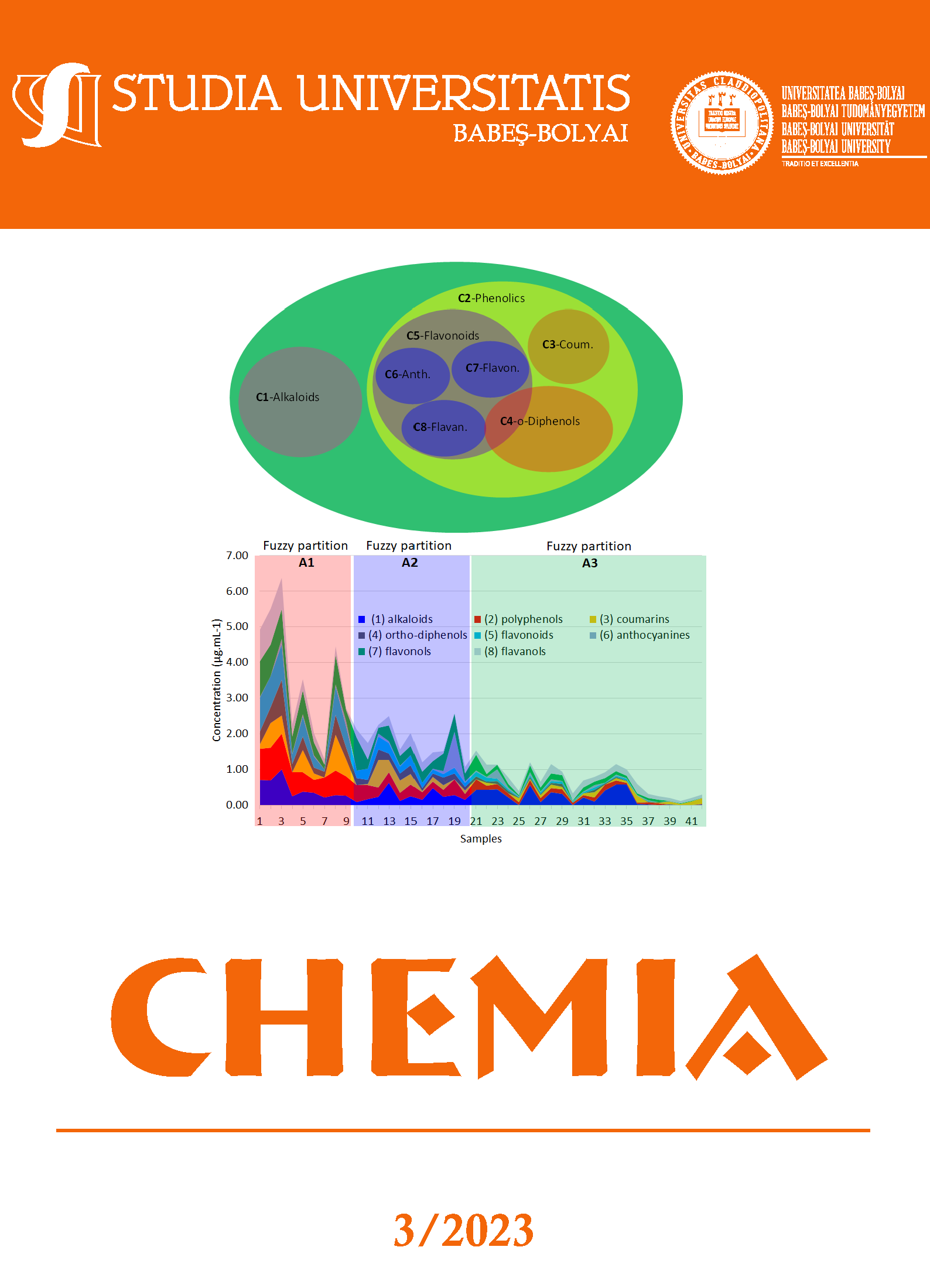TOXICITY OF HEMOGLOBIN DERIVATIZED WITH OXIDIZED ADENOSINE TRIPHOSPHATE AGAINST TUMORAL HUMAN CELLS
DOI:
https://doi.org/10.24193/subbchem.2023.3.10Keywords:
hemoglobin, cells, oATP, blood substitute, cancerAbstract
Adenosine triphosphate (ATP) has a high affinity for the organic phosphate binding site of hemoglobin (Hb), affecting the affinity for oxygen. Periodate-oxidized-ATP (oATP) behaves as an affinity tag for several enzymes that use ATP as a substrate and has the ability to form intermolecular aldimine bonds by reaction with free amino groups on proteins. Due to its unique structure, oATP has been used to produce structural and functional modifications of Hb to obtain a compound with a low affinity for oxygen that could be used as a blood substitute. However, the oATP-Hb derivative was shown to present a notable increase in pro-oxidative reactivity compared to Hb in vitro, and accordingly exhibited toxicity in in vivo studies. This pro-oxidant reactivity was alleviated by crosslinking Hb with bovine serum albumin (BSA) in an oATP-Hb-BSA copolymer. We now show that oATP and oATP-Hb-BSA display high-affinity toxicity towards cancer cells, and may hence deserve further investigation as adjuvants in anti-cancer therapy.
References
B. Giardina; I. Binotti; G. Amiconi; E. Antonini; M. Brunori; C. H. Mcmurray;
Eur. J. Biochem. 1971, 22, 327–330.
A. G. Greenburg; H. W. Kim; Crit. Care 2004, 8, 61–64.
F. Deac; B. Iacob; E. Fischer-Fodor; G. Damian; R. Silaghi-Dumitrescu;
J. Biochem. 2011, 149, 75–82.
V.-F. Scurtu; A. C. Moţ; R. Silaghi-Dumitrescu; Pharmaceuticals 2013, 6, 867–880.
D. M. Kurtz Jr.; D. P. Ballou; D. M. Kurtz Jr.; D. P. Ballou; Essays Biochem. 1999, 55–80.
E. Alomari; L. Ronda; S. Bruno; G. Paredi; M. Marchetti; S. Bettati; D. Olivari;
F. Fumagalli; D. Novelli; G. Ristagno; R. Latini; C. E. Cooper; B. J. Reeder;
A. Mozzarelli; Free Radic. Biol. Med. 2018, 124, 299–310.
T. M. S. Chang; Crit. Care Clin. 2009, 25, 373–382.
T. M. Chang; Artif Organs 2004, 28, 789–794.
R. M. Winslow; Vox Sang. 2006, 91, 102–110.
A. D. Stoica; V.-A. Toma; I. Roman; B. Sevastre; F. Scurtu; R. Silaghi-Dumitrescu; Bioinorg. Chem. Appl. 2022, 2022, 1–6.
A. D. Farcas; V. A. Toma; I. Roman; B. Sevastre; F. Scurtu; R. Silaghi-Dumitrescu; Bioinorg. Chem. Appl. 2020, 2020, 1096573.
V. A. Toma; A. D. A. D. Farcas; I. Roman; B. Sevastre; D. Hathazi; F. Scurtu;
G. Damian; R. Silaghi-Dumitrescu; Int J Biol Macromol. 2017, 107, 1422–1427.
A. Mot; A. Roman; R. Silaghi-Dumitrescu; in Metal Elements in Environment, Medicine and Biology Tome IX (eds. Silaghi-Dumitrescu R. & Garban G.) (Cluj University Press, 2009). 122–125.
F. V Deac; A. M. Bolfa; C. Magdas; B. Sevastre; S. Turc; R. Silaghi-Dumitrescu; Rom. J. Biochem. 2010, 47, 135–141.
D. Hathazi; F. Scurtu; C. Bischin; A. Mot; A. A. A. Attia; J. Kongsted; R. Silaghi-Dumitrescu; Molecules 2018, 23, E350.
F. Deac; B. Iacob; E. Fischer-Fodor; G. Damian; R. Silaghi-Dumitrescu;
J. Biochem. 2011, 149, 75–82.
F. Scurtu; O. Zolog; B. Iacob; R. Silaghi-Dumitrescu; Artif. Cells, Nanomedicine, Biotechnol. 2014, 42, 13–17.
E. Fischer-Fodor; A. Mot; F. Deac; M. Arkosi; R. Silaghi-Dumitrescu; J. Biosci. 2011, 36, 215–221.
M. Arkosi; F. Scurtu; A. Vulpoi; R. Silaghi-Dumitrescu; D. Kurtz; Artif. Cells, Nanomedicine, Biotechnol. 2017, 45, 218–223.
B. J. Reeder; M. Grey; R.-L. Silaghi-Dumitrescu; D. A. Svistunenko; L. Bülow; C. E. Cooper; M. T. Wilson; J. Biol. Chem. 2008, 283, 30780–30787.
A. C. Mot; A. Roman; I. Lupan; D. M. Kurtz; R. Silaghi-Dumitrescu; Protein J. 2010, 29, 387–393.
D. Hathazi; A. C. Mot; A. Vaida; F. Scurtu; I. Lupan; E. Fischer-Fodor; G. Damian; D. M. Kurtz Jr.; R. Silaghi-Dumitescu; Biomacromolecules 2014, 15, 1920–1927.
F. Scurtu; B. Tebrean; M. K. Árkosi; A. Ionele; R. Silaghi-Dumitrescua; Stud. Univ. Babeș-Bolyai Chem. 2019, 64, 421–434.
M. Arkosi; A. C. Mot; I. Lupan; M. G. G. Tegla; R. Silaghi-Dumitrescu; Protein J. 2023, 42, 374–382.
C. E. Cooper; R. Silaghi-Dumitrescu; M. Rukengwa; A. I. Alayash; P. W. Buehler; Biochim. Biophys. Acta - Proteins Proteomics 2008, 1784, 1415–1420.
F. Scurtu; A. Popa; R. Silaghi-Dumitrescu; Stud. Univ. Babes-Bolyai Chem. 2017, 62, 59–66.
O. Zolog; A. Mot; F. Deac; A. Roman; E. Fischer-Fodor; R. Silaghi-Dumitrescu; Protein J. 2011, 30, 27–31.
B. J. Reeder; D. A. Svistunenko; C. E. Cooper; M. T. Wilson; Antioxid. Redox Signal. 2004, 6, 954–966.
K. P. Moore; S. G. Holt; R. P. Patel; D. A. Svistunenko; W. Zackert; D. Goodier; B. J. Reeder; M. Clozel; R. Anand; C. E. Cooper; J. D. Morrow; M. T. Wilson; V. M. DarleyUsmar; L. J. Roberts; V. Darley-Usmar; L. J. Roberts 2nd; L. J. Roberts 2nd; V. M. DarleyUsmar; L. J. Roberts; J. Biol. Chem. 1998, 273, 31731–31737.
M. Lehene; E. Fischer-Fodor; F. Scurtu; N. D. Hădade; E. Gal; A. C. Mot; A. Matei; R. Silaghi-Dumitrescu; Pharmaceuticals 2020, 13, 107.
R. Silaghi-Dumitrescu; C. Gruian; C. Puscas; A. Simon; E. Fisher-Fodor; V. Al Toma; A. Farcas; I. Roman; V.-F. Scurtu; A. A. A. Attia; G. Damian; Stud. Univ. Babeș-Bolyai Chem. 2020, 65, 121–132.
B. Mureşan; C. Cimpoiu; A. Hosu; C. Bischin; E. Gal; G. Damian; E. Fischer-Fodor; R. Silaghi-Dumitrescu; Stud. Univ. Babes-Bolyai Chem. 2015, 60, 355–370.
D. Tamokou Jde; J. R. R. Chouna; E. Fischer-Fodor; G. Chereches; O. Barbos; G. Damian; D. Benedec; M. Duma; A. P. N. P. Efouet; H. K. K. Wabo; J. R. R. Kuiate; A. Mot; R. Silaghi-Dumitrescu; PLoS One 2013, 8, e55880.
B. Iacob; F. Deac; D. Cioloboc; G. Damian; R. Silaghi-Dumitrescu; Artif. Cells Blood Substitutes Biotechnol. 2011, 39, 293–297.
Downloads
Published
How to Cite
Issue
Section
License
Copyright (c) 2023 Studia Universitatis Babeș-Bolyai Chemia

This work is licensed under a Creative Commons Attribution-NonCommercial-NoDerivatives 4.0 International License.



